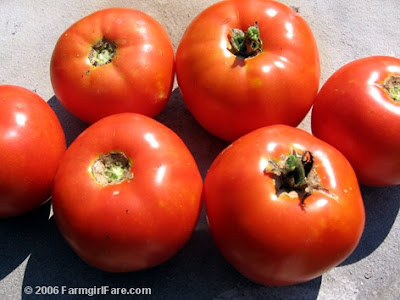
Heirloom Inspiration From A Summer Past
Great gardeners must think alike, because Cynthia Sandberg posted "Kohlrabi: A Kick-Ass Winter Veggie" on Love Apple Farm's Grow Better Veggies blog the same day I posted "Let's Trade: Your Kohlrabi Growing Tips For My Best Kohlrabi Recipe Ever" here. Of course only one of us actually qualifies as great in this case, since my kohlrabi growing attempts of late have been disasters, while Cynthia had a gorgeous winter harvest.
If you haven't yet discovered Grow Better Veggies, you're in for a real treat. Cynthia is the owner and farmer of Love Apple Farm, which is located in the Santa Cruz mountains on the central California coast and originally became known for growing 100 varieties of heirloom tomatoes each year. It is now the exclusive kitchen garden for world-renowned Manresa Restaurant in Los Gatos, California. Her Grow Better Veggies blog is "dedicated to tracking the progress of Love Apple Farm in its quest to transition to full biodynamic status, to tackle the challenges inherent in successfully providing hundreds of different kinds of edibles to Manresa Restaurant, to teach others how to grow not only the everyday popular vegetables, but also the exotic ones, and to talk a whole lot about Cynthia’s primary passion, the love apple."
If you're fortunate enough to live nearby, Cynthia gives a number of fun and informative gardening classes at the farm during the year. Love Apple Farm also offers over 100 varieties of heirloom tomato seedlings for sale at the farm in spring. Interested in some hands-on learning experience? There are volunteer opportunties at the farm as well.
Unfortunately I don't think I'll be visiting Cynthia's glorious gardens anytime soon, but I still signed up for the Love Apple Farm free e-mail newsletter. It keeps me informed about what's going on at the farm and on Grow Better Veggies, but more importantly, I get to hear about the subscribers-only contests.
Cynthia announces a new contest in each newsletter, and the current one will have 10 winners! Here's how it works:
"Anyone who leaves a nice comment on my January 24 post about kohlrabi will be entered in a raffle to win a set of 5 different and unique heirloom tomato seed packets from my friends at TomatoFest.com."
Want to win? After a short but drooling look at the TomatoFest site I know I do! Warning: they have a lot of amazing sounding heirloom tomato seeds for sale - and they're even organic. It would be really easy to go really overboard ordering seeds from this wonderful company.
To be entered in the raffle, simply subscribe to the Love Apple Farm newsletter and then leave a comment at Cynthia's kohlrabi post. There's newsletter sign-up info in the Grow Better Veggies right hand sidebar, or you can click here to go directly the mailing list sign-up page.
Whether you visit in person or in cyberspace, I think you're going to love Love Apple Farm. And who doesn't want to grow better veggies? Now if only Cynthia would send me some of that beautiful kohlrabi.
© 2008 FarmgirlFare.com, the award-winning blog where there can never be too many vine-ripened heirloom tomatoes in the kitchen garden.





